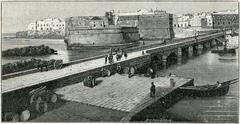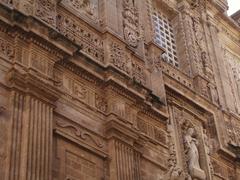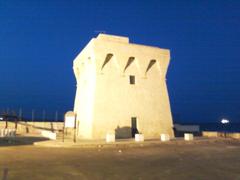
Comprehensive Guide to Visiting Gallipoli, Lecce, Italy
Published Date: 13/08/2024
Captivating Introduction
Welcome to Gallipoli, the ‘Beautiful City’ as its name translates from Greek, a place where every corner whispers tales of ancient civilizations and the sea breeze carries the scent of history. Imagine strolling through narrow, cobblestone streets where Greek warriors, Roman merchants, and Byzantine traders once walked. This coastal gem, nestled on the Ionian Sea, is more than just a vacation spot; it’s a living mosaic of rich history, breathtaking architecture, and vibrant culture. From its origins as a Greek settlement to its golden age under Roman rule, Gallipoli has been a melting pot of cultures and influences. The city’s strategic location made it a crucial port for trade and commerce, and it thrived under various rulers, each leaving their mark on its architecture and culture. Picture walking through streets adorned with Baroque buildings, where every façade tells a story of a bygone era (Wikipedia). Gallipoli isn’t just a feast for the eyes; it’s a sensory delight. Smell the salty sea breeze, hear the distant toll of church bells, taste the fresh seafood, see the pastel-colored buildings, and feel the cobblestones under your feet. Whether you’re exploring ancient ruins, enjoying local festivals like the ‘Festa di Santa Cristina,’ or simply relaxing on one of its pristine beaches, Gallipoli offers a unique blend of past and present, making it a must-visit destination for travelers seeking both adventure and tranquility (Gallipoli Experience). Ready to uncover the secrets of this enchanting town? Let’s dive into the rich history, hidden gems, and practical tips that will make your visit to Gallipoli unforgettable.
Table of Contents
- History of Gallipoli, Lecce, Italy
- Welcome to Gallipoli: The Jewel of the Ionian Sea
- Ancient Origins and Greek Influence: The Birth of Beauty
- Roman Conquest: Gallipoli’s Golden Age
- Byzantine Era and Medieval Turmoil: Rise from the Ashes
- Renaissance and Baroque Periods: A Flourish of Art and Commerce
- Unification of Italy and Modern Era: Bridging the Past and Present
- Hidden Gems and Local Secrets
- Engaging All Senses: Feel Gallipoli
- Interactive Exploration: Your Quest Awaits
- Cultural Etiquette: When in Gallipoli…
- Fun Facts and Myth Busting
- Pop Culture and Gallipoli
- Seasonal Highlights: Year-Round Magic
- Sample Itinerary: A Day in Gallipoli
- Local Lingo: Speak Like a Gallipolino
- FAQ: Your Questions Answered
- Call to Action: Discover Gallipoli with Audiala
- Visitor Tips for Gallipoli, Lecce, Italy
History of Gallipoli, Lecce, Italy
Welcome to Gallipoli: The Jewel of the Ionian Sea
Imagine a place where history breathes through every stone, and the sea whispers tales of ancient mariners. Welcome to Gallipoli, whose name means ‘Beautiful City’ in Greek. Nestled on the Ionian Sea, this coastal gem is a mosaic of ancient civilizations, breathtaking architecture, and vibrant culture. Ready to explore? Let’s dive in!
Ancient Origins and Greek Influence: The Birth of Beauty
Once upon a time, when myths were reality and gods roamed the earth, Gallipoli was born. Legend has it that Idomeneus of Crete founded this beautiful city. While historians debate its origins—was it Greek or Messapic?—what’s undeniable is the profound Greek influence that shaped its early days. As part of Magna Grecia, Gallipoli was a hub of Hellenistic culture, adorned with temples and amphitheaters. So, when you stroll through its streets, you’re walking on the very paths where ancient Greeks once tread (Wikipedia).
Roman Conquest: Gallipoli’s Golden Age
In 265 BC, the Romans marched in, recognizing Gallipoli’s strategic importance as a port for trade with the Balkans. They connected it to Rome via the Via Traiana, making it a bustling commercial hub. Imagine the hustle and bustle, the scent of spices, and the chatter in Latin! Gallipoli thrived as a municipium, enjoying a degree of autonomy under Roman rule (Italy Heritage).
Byzantine Era and Medieval Turmoil: Rise from the Ashes
Gallipoli’s story is one of resilience. After the Roman Empire’s fall, it faced invasions by the Vandals and Goths. But like a phoenix, it rose again under the Byzantines, becoming a center of trade and commerce. Fast forward to the 11th century, the Normans took over, followed by a siege by Charles I of Anjou in 1268. The city was repopulated around 1300 and withstood Venetian attempts to seize it in 1484. Talk about a drama-filled history! (Wikipedia).
Renaissance and Baroque Periods: A Flourish of Art and Commerce
The Renaissance brought a renaissance (pun intended!) to Gallipoli. Under King Ferdinand I, the port was developed, becoming the Mediterranean’s largest olive oil market by the 18th century. This era also saw the rise of Baroque architecture, with buildings adorned with floral and angelic motifs. Picture walking through streets where every building is a work of art (Gallipoli Experience).
Unification of Italy and Modern Era: Bridging the Past and Present
After Italy’s unification in 1861, Gallipoli became a modernizing force, witnessing significant urban development. The 16th-century bridge connecting the old town to the mainland symbolizes this era’s infrastructural strides. Today, it’s a vibrant blend of old and new, where history and modernity coexist in harmony (Wikipedia).
Hidden Gems and Local Secrets
While Gallipoli’s landmarks are a must-see, don’t miss the hidden gems. Wander off the beaten path to discover quaint cafes, artisanal shops, and secret courtyards. Experience local customs like the ‘Festa di Santa Cristina,’ a vibrant celebration in July that lights up the town with fireworks, processions, and music.
Engaging All Senses: Feel Gallipoli
Smell the salty sea breeze, hear the distant toll of church bells, taste the fresh seafood, see the pastel-colored buildings, and feel the cobblestones under your feet. Gallipoli is a sensory delight, a place where every corner tells a story.
Interactive Exploration: Your Quest Awaits
Ready for a challenge? Find the oldest building in Gallipoli or try to spot all the hidden angel motifs in the Baroque architecture. These mini-quests will make your exploration more engaging and fun.
Cultural Etiquette: When in Gallipoli…
To blend in like a local, remember to greet with a friendly ‘Ciao!’ and enjoy the leisurely pace of life. Italians value slow meals and good company, so take your time to savor every moment.
Fun Facts and Myth Busting
Did you know Gallipoli’s Greek Fountain is one of Italy’s oldest? While some believe it dates back to the 3rd century BC, others argue it’s a Renaissance creation. Either way, it’s a fascinating piece of history (Gallipoli Experience).
Pop Culture and Gallipoli
Gallipoli has inspired artists and filmmakers alike. While it may not be a frequent movie backdrop, its picturesque landscape and historical depth make it a hidden gem for creative minds.
Seasonal Highlights: Year-Round Magic
Gallipoli transforms with the seasons. Summer brings beach bliss and festivals, while winter offers a serene escape with fewer tourists. Spring and autumn are perfect for cultural explorations and enjoying the mild weather.
Sample Itinerary: A Day in Gallipoli
- Morning: Start with a visit to Gallipoli Castle. Climb to the top for stunning views.
- Midday: Lunch at a local trattoria. Try the seafood risotto!
- Afternoon: Explore the old town, visit the co-cathedral basilica of Sant’Agata, and take a stroll along the bastion walls.
- Evening: Relax at the beach and enjoy a sunset aperitivo.
Local Lingo: Speak Like a Gallipolino
Learn some local phrases to charm the residents:
- ‘Buongiorno’ (Good morning)
- ‘Grazie’ (Thank you)
- ‘Dove è il bagno?’ (Where is the bathroom?)
FAQ: Your Questions Answered
- Q: When is the best time to visit Gallipoli?
- A: Spring and autumn are ideal for mild weather and fewer tourists.
- Q: What is Gallipoli famous for?
- A: Its rich history, Baroque architecture, and beautiful beaches.
- Q: Is Gallipoli suitable for families?
- A: Absolutely! There are plenty of family-friendly activities and attractions.
Call to Action: Discover Gallipoli with Audiala
Ready to uncover Gallipoli’s secrets? Download the Audiala app for beautifully crafted audio guides that bring the city’s history and culture to life. Explore with confidence and let Audiala be your personal guide to this enchanting town. Download now and start your adventure!
Visitor Tips for Gallipoli, Lecce, Italy
Introduction
Welcome to Gallipoli, the Pearl of the Ionian Sea! Picture a sun-dappled coastal town where history whispers through ancient walls, and the aroma of freshly grilled seafood fills the air. Whether you’re chasing the thrill of beach parties or yearning for a serene stroll through cobblestone streets, Gallipoli has a slice of paradise waiting just for you.
Best Time to Visit
Gallipoli offers a variety of experiences throughout the year. For a taste of local life without the hustle and bustle, visit in May or September when the weather is delightful and the crowds are minimal. Imagine lazy afternoons on near-empty beaches and leisurely dinners under the stars. The summer months of June to August are perfect for sun worshippers but be prepared for lively, crowded beaches. December and January can be quite chilly, perfect for cozying up with a glass of local wine.
Getting There
Getting to Gallipoli is easier than you think. While the Ferrovie del Sud Est train and bus lines are handy, renting a car is your golden ticket to hidden beaches and quaint inland towns. The city itself is a walker’s dream. If you’re flying into Brindisi International Airport (BDS), a 45-minute drive will get you to Gallipoli. Pro tip: Book a car through Hertz, Eurocar, or Alamo for a smooth ride (Discovercars.com).
Accommodation
From grand historic palazzos to cozy beachfront hotels, Gallipoli has it all. For a truly unique experience, why not stay in a centuries-old palazzo? Book early during the peak summer months to snag the best spots and rates (Booking.com).
Beaches
Gallipoli’s beaches are nothing short of spectacular. Here are some local favorites:
- Purity Beach: Nestled below the historic walls of Old Town, this beach is a family favorite. Its shallow, clear waters are perfect for a quick dip, though amenities are sparse (A Taste for Travel).
- Spiaggia G Beach: With crystal-clear waters and amenities like sun loungers and a restaurant, it’s perfect for a laid-back day by the sea (A Taste for Travel).
- Samsara Beach: Ready to party? Samsara Beach is the place to be, with lively DJ sets and concerts (A Taste for Travel).
Dining
Gallipoli’s culinary scene is a feast for the senses. Don’t leave without trying:
- Orecchiette: This classic pasta dish often comes with tomato sauce, meat, or veggies.
- Frisella: Dried bread soaked in water and topped with tomatoes, olive oil, and oregano.
- Seafood: Freshly caught and expertly prepared, seafood here is a must-try.
For an unforgettable meal, head to Solatio near Torre Suda and savor sweet shrimp grilled with olive oil, lemon, and sea salt (A Taste for Travel).
Activities and Attractions
There’s never a dull moment in Gallipoli:
- Museo Arte Contemporanea Matino: Explore contemporary art in the historic Palazzo Marchesale (A Taste for Travel).
- Historic Old Town: Wander through narrow streets, visit Gallipoli Castle, and marvel at the Cathedral of Sant’Agata.
- Boat Tours: Discover hidden coves and beaches along the Ionian coastline.
- Day Trips: Explore nearby villages like Racale, just a 20-minute drive south, for a taste of local life (A Taste for Travel).
Practical Tips
- Footwear: Sturdy shoes are a must for navigating cobblestone streets and staircases. Opt for comfortable sandals in summer and water-resistant shoes in winter (Savoring Italy).
- Packing: Pack layered clothing for summer and warmer clothes for winter. Check the forecast before you go (Savoring Italy).
- Travel Insurance: Consider World Nomads Travel Insurance for peace of mind (World Nomads).
- Car Rental: Use Discovercars.com to compare rental options and find the best deals (Discovercars.com).
Local Lingo Lessons
Brush up on some Italian to blend in with the locals. Here are a few phrases:
- Ciao! (Hello/Goodbye)
- Grazie (Thank you)
- Dove è il bagno? (Where is the bathroom?)
- Un gelato, per favore (One ice cream, please)
Time-Based Itineraries
For a day in Gallipoli, consider this itinerary:
- Morning: Start with a stroll through Old Town and visit the Gallipoli Castle.
- Afternoon: Relax on Purity Beach and enjoy a seafood lunch.
- Evening: Head to Spiaggia G Beach for a sunset dinner and cocktails.
Call to Action
Unlock more secrets and stories of Gallipoli with the Audiala tour guide app. Download it before your visit to enhance your exploration with beautifully crafted audio guides. Don’t miss out on the hidden gems that only Audiala can reveal!
Call to Action
As we conclude our journey through Gallipoli, it’s clear that this coastal jewel offers a unique blend of historical depth and modern charm. From its ancient origins, influenced by Greek and Roman civilizations, to its vibrant present, Gallipoli stands as a testament to resilience and cultural richness. Whether you’re exploring the ancient streets of the old town, marveling at Baroque architecture, or enjoying the local culinary delights, Gallipoli engages all your senses and leaves you with lasting memories. The city’s seasonal transformations offer something for everyone, from the lively beaches of summer to the serene beauty of winter. For an immersive experience, don’t forget to download the Audiala app, your personal guide to uncovering Gallipoli’s hidden gems and stories. Let Audiala enhance your adventure with expertly crafted audio guides that bring the city’s rich history and vibrant culture to life. So, pack your bags, brush up on your local lingo, and get ready to explore Gallipoli, where every corner holds a new story waiting to be discovered.
References
- Wikipedia. (n.d.). Gallipoli, Apulia. Retrieved from https://en.wikipedia.org/wiki/Gallipoli,_Apulia
- Italy Heritage. (n.d.). Gallipoli. Retrieved from https://www.italyheritage.com/regions/puglia/lecce/gallipoli.htm
- Gallipoli Experience. (n.d.). Cultural Heritage. Retrieved from https://gallipoliexperience.it/en/2020/12/15/cultural-heritage/
- A Taste for Travel. (n.d.). Where to Stay in Puglia. Retrieved from https://www.atastefortravel.ca/11890-where-to-stay-in-puglia/
- Savoring Italy. (n.d.). Lecce Travel Guide. Retrieved from https://www.savoringitaly.com/lecce-travel-guide/
- Discovercars.com. (n.d.). Car Rental. Retrieved from https://www.discovercars.com
- World Nomads. (n.d.). Travel Insurance. Retrieved from https://www.worldnomads.com






